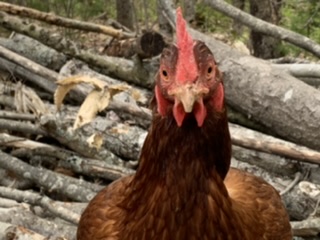Introducing Ivy our Little Lamb
Our Castonguay This’N’That Family Farm just had some great big learning experiences with the lambing process.
Alexia was there at 11:30 at night on Saturday, February 20th for the birth and the newborn care of little Ivy. Along with myself and husband, Justin. This photo is right after we cleared her nose and dried her up after birth. There is a red hue because the heat lamps are on.
We are definitely exhausted from the checkups and the labor and delivery, but we are also so thrilled to have a thriving baby lamb in our barn.
I wanted to share with you all as soon as possible the good news of her birth. She had a quick check the next day by the farmers who we got her mama from and she is 12 pounds. Note: (we need a little scale).
For a baby lamb, that’s great. She’s staying warm with her little sweater: hand knit by Ann Salisbury for our youngest son. Thank you Ann; he grew out of it just in time. We have two warming lamps set up over the pen and she is drinking her milk very well.
The Southdown sheep Mama named Dolly, or as I now like to call her: the Dolly Mama, is doing a great job caring for her newborn lamb.
Lambs have the highest risk of death in the first 48 hours after birth, so we are checking on Ivy and Dolly often. Our other Southdown sheep Rosie, lost her baby and we are doing everything possible to give Ivy a better chance despite the freezing temperatures!
At the time of this writing, we are just about the 24 hour mark and she is going strong. I am going to use the information we gained from this experience to put together a learning post about lambing from the early signs to the newborn care. There will be videos and one small graphic clip of the delivery.
Link to video of Ivy on Pinterest
Here is one snippet of a video of our lively little Ivy... I’m working with tech support to have it show here, but it takes a while... in the meantime try this link.

Having six of my own babies, definitely helped me connect with our laboring ewe and new baby. The pediatric experience helped too, but I’ve never been part of a delivery team, so this angle of birth was different.

The other sheep in the flock showed their concern for Dolly during labor and seemed to support her. They were also interested in meeting little Ivy, especially after she started bleating. Rosie had been doing well since her loss, but the addition of Ivy has brought on some sadness; she understands now what she lost.
It was such a thrill to be there to help this ewe and newborn lamb. Come back again soon to get more updates on our newest friend and more details of our busy night.

While you are here, please mark yourself a follower in the top right corner of the blog! And if you have any thing you want to share, comment below; we want to hear how far our backyard farm life is traveling and we want our readers to see too! Comments are screened before showing up on this blog. Check back in a couple days and it will be up.























